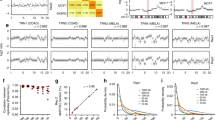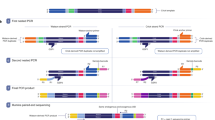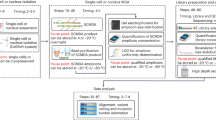Abstract
With the increasing emergence of genome-wide analysis technologies (including comparative genomic hybridization (CGH)1, expression profiling on microarrays2, differential display (DD)3, subtractive hybridization, and representational difference analysis (RDA)4,5), there is frequently a need to amplify entire genomes or cDNAs by PCR to obtain enough material for comparisons among target and control samples. A major problem with PCR is that amplification occurs in a nonlinear manner and reproducibility is influenced by stray impurities6. As a result, when two complex DNA populations are amplified separately, the quantitative relationship between two genes after amplification is generally not the same as their relation before amplification7. Here we describe balanced PCR, a procedure that faithfully retains the difference among corresponding amplified genes by using a simple principle. Two distinct genomic DNA samples are tagged with oligonucleotides containing both a common and a unique DNA sequence. The genomic DNA samples are pooled and amplified in a single PCR tube using the common DNA tag. By mixing the two genomes, PCR loses the ability to discriminate among the different alleles and the influence of impurities is eliminated. The PCR-amplified pooled samples can be separated using the DNA tag unique to each individual genomic DNA sample. The principle of this method has been validated with synthetic DNA, genomic DNA, and cDNA applied on microarrays. By removing the bias of PCR, this method allows a balanced amplification of allelic fragments from two complex DNAs even after three sequential rounds of PCR. This balanced PCR approach should allow genetic analysis in minute laser-microdissected tissues, paraffin-embedded archived material, or single cells.
This is a preview of subscription content, access via your institution
Access options
Subscribe to this journal
Receive 12 print issues and online access
$209.00 per year
only $17.42 per issue
Buy this article
- Purchase on Springer Link
- Instant access to full article PDF
Prices may be subject to local taxes which are calculated during checkout


Similar content being viewed by others
References
Kallioniemi, A. et al. Detection and mapping of amplified DNA sequences in breast cancer by comparative genomic hybridization. Proc. Natl. Acad. Sci. USA 91, 2156–2160 (1994).
Schena, M., Shalon, D., Davis, R.W. & Brown, P.O. Quantitative monitoring of gene expression patterns with a complementary DNA microarray. Science 270, 467–470 (1995).
Liang, P. & Pardee, A.B. Differential display of eukaryotic messenger RNA by means of the polymerase chain reaction. Science 257, 967–971 (1992).
Lisitsyn, N. & Wigler, M. Cloning the differences between two complex genomes. Science 259, 946–951 (1993).
Hubank, M. & Schatz, D.G. Identifying differences in mRNA expression by representational difference analysis of cDNA. Nucleic Acids Res. 22, 5640–5648 (1994).
Heid, C., Stevens, J., Livak, K. & Williams, P. Real time quantitative PCR. Genome Res. 6, 986–994 (1996).
Lucito, R. et al. Genetic analysis using genomic representations. Proc. Natl. Acad. Sci. USA 95, 4487–4492 (1998).
Zhang, Y. et al. Reproducible and inexpensive probe preparation for oligonucleotide arrays. Nucleic Acids Res. 29, E66 (2001).
Shirota, Y., Kaneko, S., Honda, M., Kawai, H.F. & Kobayashi, K. Identification of differentially expressed genes in hepatocellular carcinoma with cDNA microarrays. Hepatology 33, 832–840 (2001).
Bartosiewicz, M., Trounstine, M., Barker, D., Johnston, R. & Buckpitt, A. Development of a toxicological gene array and quantitative assessment of this technology. Arch. Biochem. Biophys. 376, 66–73 (2000).
Van Gelder, R.N. et al. Amplified RNA synthesized from limited quantities of heterogeneous cDNA. Proc. Natl. Acad. Sci. USA 87, 1663–1667 (1990).
Sgroi, D.C. et al. In vivo gene expression profile analysis of human breast cancer progression. Cancer Res. 59, 5656–5661 (1999).
Emmert-Buck, M.R. et al. Laser capture microdissection. Science 274, 998–1001 (1996).
Zimmermann, J.W. & Schultz, R.M. Analysis of gene expression in the preimplantation mouse embryo: use of mRNA differential display. Proc. Natl. Acad. Sci. USA 91, 5456–5460 (1994).
Klein, C.A. et al. Comparative genomic hybridization, loss of heterozygosity, and DNA sequence analysis of single cells. Proc. Natl. Acad. Sci. USA 96, 4494–4499 (1999).
Youmell, M., Park, S.J., Basu, S. & Price, B.D. Regulation of the p53 protein by protein kinase C alpha and protein kinase C zeta. Biochem. Biophys. Res. Commun. 245, 514–518 (1998).
Chakrabarti, S. et al. Highly selective isolation of unknown mutations in diverse DNA fragments: toward new multiplex screening in cancer. Cancer Res. 60, 3732–3737 (2000).
Dallman, M.J. & Porter, A.C.G. PCR1: A Practical Approach (Oxford Univ. Press, Oxford, UK, 1996).
Acknowledgements
We thank K. Ardlie (Genomics Collaborative) and D. Sgroi (Massachusetts General Hospital Department of Pathology) for helpful comments and suggestions. This work was supported in part by Genomics Collaborative (Cambridge, MA).
Author information
Authors and Affiliations
Corresponding author
Ethics declarations
Competing interests
The authors declare no competing financial interests.
Rights and permissions
About this article
Cite this article
Makrigiorgos, G., Chakrabarti, S., Zhang, Y. et al. A PCR-based amplification method retaining the quantitative difference between two complex genomes. Nat Biotechnol 20, 936–939 (2002). https://doi.org/10.1038/nbt724
Received:
Accepted:
Published:
Issue Date:
DOI: https://doi.org/10.1038/nbt724
This article is cited by
-
An enzyme-free electrochemical sandwich DNA assay based on the use of hybridization chain reaction and gold nanoparticles: application to the determination of the DNA of Helicobacter pylori
Microchimica Acta (2020)
-
Electroanalysis of single-nucleotide polymorphism by hairpin DNA architectures
Analytical and Bioanalytical Chemistry (2013)
-
Multiple displacement amplification for complex mixtures of DNA fragments
BMC Genomics (2008)
-
A protocol for the in vitro selection of specific oligonucleotide probes for high-resolution DNA typing
Nature Protocols (2007)
-
Two-dimensional strandness-dependent electrophoresis
Nature Protocols (2006)



